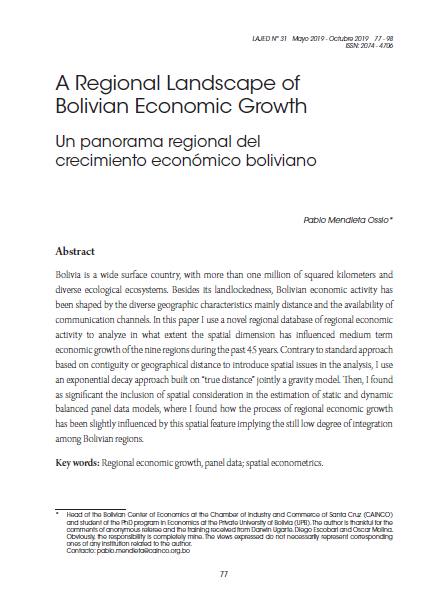A Regional Landscape of Bolivian Economic Growth
DOI:
https://doi.org/10.35319/lajed.201931347Keywords:
Regional economic growth, panel data, spatial econometricsAbstract
Bolivia is a wide surface country, with more than one million of squared kilometers and diverse ecological ecosystems. Besides its landlockedness, Bolivian economic activity has been shaped by the diverse geographic characteristics mainly distance and the availability of communication channels. In this paper I use a novel regional database of regional economic activity to analyze in what extent the spatial dimension has influenced medium term economic growth of the nine regions during the past 45 years. Contrary to standard approach based on contiguity or geographical distance to introduce spatial issues in the analysis, I use an exponential decay approach built on “true distance” jointly a gravity model. Then, I found as significant the inclusion of spatial consideration in the estimation of static and dynamic balanced panel data models, where I found how the process of regional economic growth has been slightly influenced by this spatial feature implying the still low degree of integration among Bolivian regions.
Downloads
References
Álvarez, Inmaculada; Barbero, Javier and Zoo, José. (2017). “A panel data toolbox for Matlab”. Journal of Statistical Software, 76(6), 1-27.
Anselin, Luc. (1988). Spatial Econometrics: Methods and Models. Kluwer Academic Publisher.
Anselin, Luc and Rey, Sergio Joseph (2014). Modern Spatial Econometrics in Practice: A Guide to GeoDa, GeoDaSpace and PySAL. Chicago: GeoDa Press.
Arellano, Manuel and Bond, Stephen. (1991). “Some tests of specification for panel data: Monte Carlo evidence and an application to employment equations”. The Review of Economic Studies, 58(2), 277-297.
Arvis, J.F.; Raballand, G. and Marteau, J.F. (2010) The Cost of Being Landlocked: Logistics Costs and Supply Chain Reliability. Directions in Development. World Bank Publications.
Baltagi, Badi and Li, Dong. (2002). “Series estimation of partially linear panel data models with fixed effects”. Annals of Economics and Finance, 3(1):103-116.
Belotti, Federico; Hughes, Gordon and Piano Mortari, Andrea. (2017). “Spatial panel data models using Stata”. Stata Journal, 17(1), 139-180.
Chen, Yanguang. (2012). “On the four types of weight functions for spatial contiguity matrix”. Letters in Spatial and Resource Sciences, 5(2), 65-72.
---------- (2015). “The distance-decay function of geographical gravity model: Power law or exponential law?”. Chaos, Solitons & Fractals, (77), 174-189.
COPSCZ. (1982). Diagnóstico agropecuario del departamento de Santa Cruz. Comité de Obras Públicas de Santa Cruz.
Day, Jennifer and Lewis, Blane. (2013). “Beyond univariate measurement of spatial autocorrelation: disaggregated spillover effects for Indonesia”. Annals of GIS, 19(3), 169-185.
Elhorst, J. Paul. (2003). Specification and estimation of spatial panel data models. International Regional Science Review, 26(3), 244-268.
---------- (2013). Spatial Econometrics: From Cross-Sectional Data to Spatial Panels. Springer Briefs in Regional Science. Springer Berlin Heidelberg.
Shehata, Emad-Abd Elmessih and Mickaiel, Khaleel Sahra (2012). "Spregdpd: Stata module to estimate spatial panel Arellano-Bond linear dynamic regression: Lag & Durbin models". Statistical Software Components, Boston College Department of Economics.
Fiaschi, Davide and Parenti, Angela. (2014). “How Reliable are the Geographical Spatial Weights Matrices?” Region et Developpement, (40), 53-68.
INE-Bolivia. (1992). “Cuentas regionales de Bolivia por actividad economica (serie 1980-1986)”. Instituto Nacional de Estadistica, Division de Cuentas Regionales.
Lee, Lung-fei and Yu, Jihai. (2014). “Efficient GMM estimation of spatial dynamic panel data models with fixed effects”. Journal of Econometrics, 180(2), 174-197.
LeSage, James and Chih, Yao-Yu. (2017). “A matrix exponential spatial panel model with heterogeneous coefficients”. Geographical Analysis, 50 (4), 422-453.
Mendieta, Pablo and Martin, Dennise. (2009). “En busca de los determinantes del crecimiento económico boliviano”. Document presented at the 2009 Bolivian Conference on Development Economics.
Montero, Casto and Del-Río, Marco. (2013). Convergencia en Bolivia: un enfoque espacial con datos de panel dinámicos”. Revista de Economía del Rosario, 16 (2), 233.
Morales, Juan Antonio and Sachs, Jeffrey D. (1989). “Bolivia’s Economic Crisis”, book 3, 57-80. University of Chicago Press.
Paudel, Ramesh C. (2014). “Economic growth in developing countries: Is landlockedness destiny?”. Economic Papers: A journal of applied economics and policy, 33(4), 339-361.
Robertson, Peter E. and Robitaille, Marie-Claire. (2017). “The tyranny of distance and the gravity of resources”. Economic Record, 93(303), 533-549.
Verardi, Vincenzo and Croux, Christophe. (2009). “Robust regression in stata”. Stata Journal, 9(3), 439-453.
Verardi, Vincenzo and Libois, Francois. (2012). “XTSEMIPAR: Stata module to compute Semiparametric Fixed-Effects Estimator of Baltagi and Li”. Statistical Software Components, Boston College Department of Economics, February, 2012.
Villarroel, David. (1992). “Descentralización y políticas de población (Bolivia)”. Technical report, CEPAL. Disponible en: http://repositorio.cepal.org/handle/11362/21203.
Wooldridge, J.M. (2010). Econometric Analysis of Cross Section and Panel Data. MIT Press.






